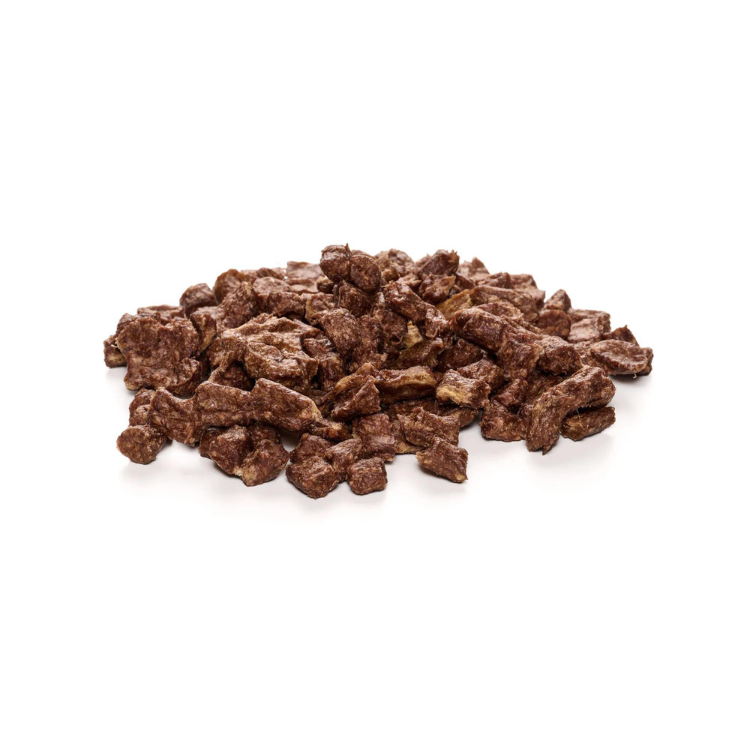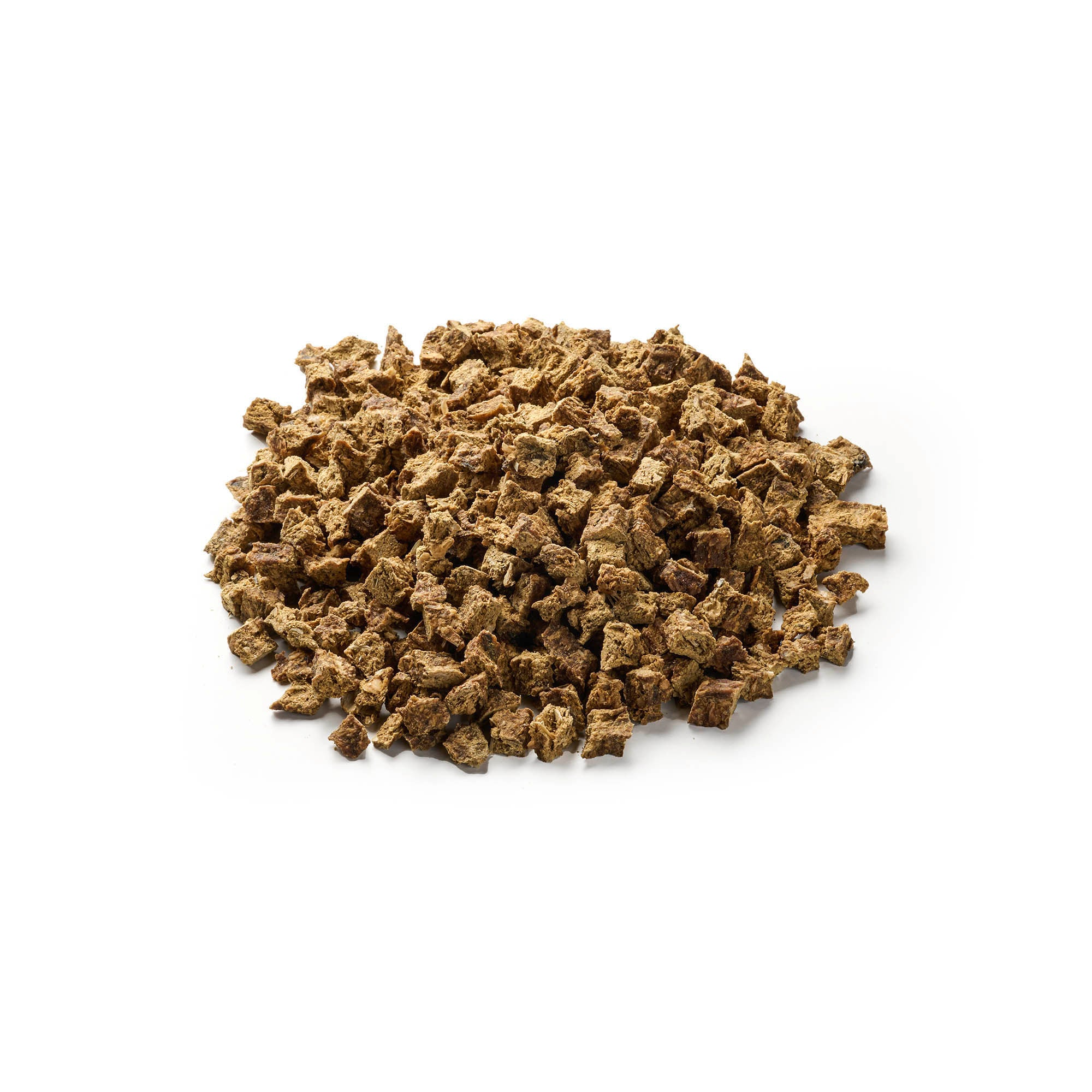
Allergy in dogs - things you should consider
Share
It is estimated that around 20 percent of all dogs suffer from allergies. Certain types of allergies are particularly common. However, with the right diagnosis and treatment, it is possible to give your dog a happy, symptom-free life despite the allergy.
The goal for dog owners should be to diagnose the dog's allergy with the help of a veterinarian, avoid the respective triggers and relieve symptoms with the right treatment.
Content: Allergies in dogs- What can cause allergies in dogs?
- Allergies in dogs: symptoms
- Diagnosis - Recognizing allergies in dogs
- What to do if your dog is allergic?
- Common allergies in dogs
- Conclusion
Discover the range of dog snacks in our store!
What can cause allergies in dogs?
What is an allergy in dogs? An allergy in dogs is an excessive physical defense reaction or hypersensitivity to certain environmental substances that does not occur in other dogs.
There are many different causes and triggers of allergic reactions in dogs, as in humans.
As an overreaction of the immune system to an otherwise harmless substance, the body perceives a danger and tries to fight it off. The substance that triggers the allergic reaction is called an allergen.
Many dogs are born with a tendency to develop allergies. The more often a dog comes into contact with a particular allergen, the higher the risk that the immune system will eventually overreact and the allergy will break out.
Allergies in dogs: symptoms
There are different symptoms and reactions that can occur when a dog is allergic. Constant itching, scratching and biting in the same places can be the first signs of an allergy.
The first signs of an allergy in dogs are often sore, scratched areas of skin on the body. Chronically inflamed ears can also indicate an allergy.
Intolerances caused by food allergies can also cause diarrhea and general gastrointestinal problems.
Typical signs and symptoms of an allergy
- Redness, rash and purulent inflammation and other skin problems
- Loss of fur, often on spots or on the belly. Frequent scratching and licking.
- Diarrhea , flatulence and vomiting and other digestive problems
- Inflammation of the ears (especially in the case of food allergies)
- Swelling and edema on the neck or paws
- Frequent biting of the rear end or base of the tail
As a dog owner, you can only be completely sure if you visit a vet and have an allergy test carried out. This will protect your dog from misdiagnosis and incorrect treatment.
An allergy test for a dog costs approximately €200 – €600 depending on the number of allergens tested and the veterinarian’s fee.
Diagnosis - Recognizing allergies in dogs
Diagnosing the actual allergy is difficult. Blood tests and allergy tests alone are often not enough to make a meaningful decision.
If your dog notices the symptoms mentioned above, you should see a veterinarian as soon as possible.
He or she can carry out appropriate tests to determine whether it is actually an allergy or whether your pet is suffering from poisoning or an illness with similar symptoms.
Exclude alternatives
Other diseases should be ruled out beforehand. Parasitic infestations such as worms, fleas and mites can cause similar symptoms. Veterinarians try to find evidence of parasitic infestation.
To achieve this, the samples are examined in the laboratory using a microscope. Using the exclusion process, diseases that could be caused by an allergy based on the symptoms can be gradually ruled out.
Only then does the clinical examination typically follow.
Allergy testing in dogs: Clinical examination
Allergy test: There are various test methods available for an allergy test in dogs: in vitro test or intradermal test. In the in vitro test, the vet takes a blood sample from the dog and has it examined in a laboratory for antibodies.
This allows the vet to determine whether there are antibodies against the various allergens in the blood, although the test does not always produce clear results. Antibodies can be found in the blood even though the dog does not react at all or hardly at all to these allergens.
Conversely, antibodies that are only present in small numbers in the blood can also cause severe symptoms. The allergy test in dogs can also be carried out via the skin. In the intradermal test, possible allergy triggers are injected under the skin.
If the skin shows reactions such as redness and hives, an allergy is probably present. However, exclusion diets are recommended to identify food allergies.
If both allergy tests are carried out in combination, the highest hit rate is achieved.
Exclusion diet
Only in the case of food intolerance should an exclusion diet be used over a longer period of time to check whether the symptoms change.
High quality dog snacks to pamper your dog, now available!
What to do if your dog is allergic?
If your dog has been diagnosed with an allergy, you should be prepared for lifelong treatment, as a complete cure for the allergy is not possible.
Avoid contact with allergens & prophylaxis
The most effective treatment is to strictly avoid contact with the allergen responsible. Allergies cannot be cured, but can only be controlled. Optimal prophylaxis for the patient all year round is particularly important. In the case of flea bite allergies, a single flea bite is enough to reactivate the allergy.
Medication and desensitization
Medication can also help to relieve the acute symptoms of your dog's allergy. It is also possible to desensitize your dog and get his body used to the trigger of his allergy.
Individual treatment
Unfortunately, there is no one-size-fits-all treatment method. Dog owners should work closely with their veterinarian to find the best treatment and therapy for their dog and to implement it consistently.
Common allergies in dogs
Which allergies occur most frequently in dogs? There are various substances that can be allergens and trigger an allergy.
However, if a dog does suffer from an allergy, there is a high probability that it is either atopic dermatitis, a flea bite allergy or a food allergy.
Overview of allergies:
Flea bite allergy
Fleas are a nuisance for dogs and dog owners and require immediate and thorough treatment. In some dogs, flea infestation also leads to what is known as a flea bite or flea saliva allergy.
Flea bite allergy is one of the most common skin diseases in dogs and is caused by a hypersensitivity reaction to antigenic components of flea saliva.
Caused
The allergic reaction is caused by protein compounds in flea saliva. A flea bite allergy can therefore occur in principle in any dog that is infested with fleas. The disease usually begins in the summer, but symptoms last all year round.
A single flea bite is enough to trigger or maintain the allergy, because old bites are reactivated by a new flea bite and raised hives appear.
Symptoms
In addition to itching, hair loss, thickening of the skin and redness, dogs react to flea saliva with skin inflammation with typical crusting and scaling along the back, especially on the back and base of the tail, the inside of the thighs and down to the hind legs.
In severe cases, they can spread to the armpits and neck region, and even the neck area and ears are eventually affected.
diagnosis
The characteristic clinical symptoms and the presence of fleas or flea droppings usually provide reliable clues. An allergy test can also be carried out to confirm the diagnosis.
Treatment
The first priority is thorough flea control and consistent prophylaxis. The dog's entire environment must be taken into account, as fleas are only on the dog for a short time. Otherwise, they stay in the environment where they lay their eggs:
- Regularly vacuum the entire apartment, especially the sleeping and lying areas. It is also useful to treat the vacuum cleaner bag with an anti-parasitic agent.
- Wash blankets, pillows, etc. and ideally spray the entire apartment with an antiparasitic spray
- Treat all dog areas in the car, garden, kennel, dog house with an antiparasitic agent
- Treat other animals in the household
The main aim of therapy is to relieve and control the painful itching. Special cortisone preparations and antihistamines are often used for this purpose. Anti-itch and skin-soothing shampoos can also provide relief.
Depending on the severity of the skin changes, antibiotics may also be necessary. Optimal flea prevention for dogs all year round is particularly important, because a single flea bite is enough to cause the allergy to flare up again.
Environmental allergy (atopic dermatitis)
Atopic dermatitis is widespread in dogs and is particularly evident in skin problems. Numerous substances from the environment can act as allergens, which is why it is also referred to as an environmental allergy.
Caused
Possible triggers of atopic dermatitis in dogs include pollen, mold and house dust mites. Depending on the allergen, the symptoms occur either seasonally or all year round.
Symptoms
Typical symptoms include skin inflammation on the head, especially on the ears, but also on the paws, in the armpits, the groin area or around the anus; inflamed areas on the back and neck are also possible. Symptoms often appear in the second or third year of life.
diagnosis
Atopy usually develops in a dog's second or third year of life. If it occurs seasonally, the trigger for your dog's skin inflammation could be pollen. The vet will do a blood and intracutaneous test to detect atopic dermatitis.
Treatment
In the case of atopic dermatitis, it is more difficult to avoid contact with the allergen. However, medication can help to alleviate the acute symptoms of the allergy in dogs.
- Every three days, use special shampoo and cool water to flush allergens from the skin, which reduces itching
- Cortisone-containing ointments or tablets also help against itching
- Alternatively: "Ciclosporin" or antihistamines, combined with omega-3 fatty acids to reduce harmful amounts of cortisone
- During hyposensitization, highly diluted allergens are injected under the skin over a longer period of time. The dosage increases each time.
Food allergy
Can dog food cause allergies? Yes, food allergies in dogs are becoming more common and are the third most common allergy disease in dogs. Dogs often do not tolerate certain protein sources (proteins, glycoproteins, etc.).
Caused
Allergies in dogs are often triggered by the consumption of certain animal protein sources such as beef , chicken, dairy products, potatoes, eggs and soy.
Some types of grain are also considered a possible cause of food allergies in dogs. Many manufacturers include these in large quantities in their dog food.
Symptoms
Typical symptoms of a food allergy in dogs are skin inflammation (atopy) or chronic ear infections (otitis). Inflammation in the stomach and intestines can also cause diarrhea or digestive problems.
diagnosis
Elimination diet – The elimination process attempts to find the food that causes the allergy.
To initially identify the allergy trigger, the dog is fed only a protein source that is new to him (e.g. horse meat) for between 8 and 12 weeks, using only one carbohydrate source (e.g. potatoes) if possible.
Then carefully mix proteins into the food and record which ones the dog reacts positively or negatively to. Only one additional source should be added every two to three weeks so that the trigger can be identified.
The dog must not be given any other food during this time.
Treatment
There is special allergy food that contains only proteins that the dog's organism is not yet familiar with.
Special types of dog food in which the amino acids have been broken down (hydrolyzed) to such an extent that the immune system can no longer recognize them are also helpful.
Alternatively: "Ciclosporin" or antihistamines, combined with omega-3 fatty acids to reduce harmful amounts of cortisone.
During hyposensitization, highly diluted allergens are injected under the skin over a longer period of time. The dosage increases each time.
Therefore, the dog can continue to be fed a balanced diet despite the allergy.
Contact allergy
In some dogs, contact with certain materials, substances such as plant parts, chemicals, metals, household products or fragrances causes allergic reactions.
It is therefore called a contact allergy and is a disease that occurs less frequently than other allergies, but can be very unpleasant for the affected dog.
The itching causes redness and swelling of the skin, especially in hairless areas. Purulent crusts or small ulcers can form.
Caused
Possible allergy triggers include rubber, cleaning and household products, fragrances, metals, chemicals, plant parts, etc., which can be found on objects such as toys, bowls, collars, dog leashes or other everyday objects.
Symptoms
Inflammation, redness and swelling can often be seen at the typical contact points such as the stomach, mouth, collar area or paws. If unsuitable care products and shampoos are used, it can also occur all over the body.
diagnosis
It is difficult to identify the allergens of a contact allergy in dogs because an epicutaneous test, in which the substances are stuck to the skin, is not feasible in dogs.
One possible diagnosis would be to prohibit contact with the suspected object for eight weeks. Then confront the dog with the object and observe its reactions closely.
Treatment
Banish the allergy trigger from the household
Avoiding allergens
Replacing the collar, food bowl or the respective suspected object
Conclusion
Certain types of allergies such as food allergies, environmental allergies or flea bite allergies are particularly common in dogs.
However, with a correct diagnosis and individually tailored treatment of the allergy, it is possible to give your four-legged friend a symptom-free and happy life despite the allergy.
With the help of your vet, you can diagnose the triggers and then consistently avoid the corresponding allergens if possible. Symptoms can be alleviated with the right treatment, even if it sometimes requires lifelong therapy for your dog.
Self-experiments and blog posts are no substitute for a thorough diagnosis by a veterinarian.
Delicious dog snacks for pure enjoyment are available from us!













